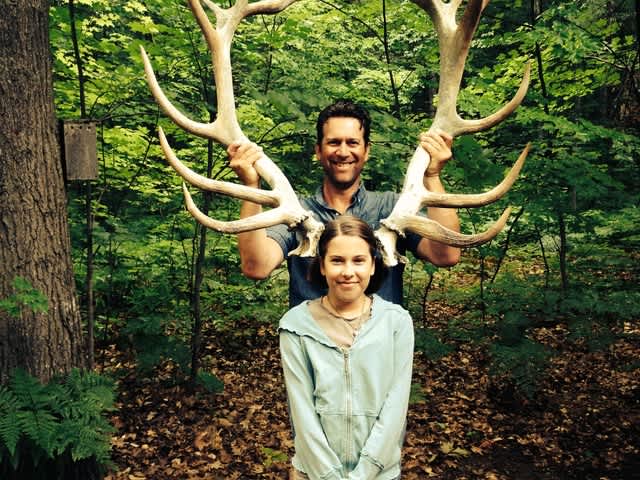Michigan Girl Uncovers 160-year-old Skeleton of Extinct Elk
OutdoorHub Reporters 08.07.14

Standing ramrod straight, 10-year-old Sonja Moehle reaches perhaps a little over five feet. For comparison, the massive elk antlers she found in a Michigan lake earlier this lake both reach her chin. Sonja, who prefers to be called “Sunny,” discovered the rack, and plenty of other bones, while canoeing with her dad around a Northern Michigan lake back in April. Sonya initially thought the antlers were just oddly-shaped sticks or even dinosaur bones, but her dad, David Moehle, knew better.
“He brought his fishing pole,” Sonja told Interlochen Public Radio. “So he shoved it down there and he grabbed it and he pull it up. And it was this giant vertebra and we were like, ‘What?’ Crazy!”
The two continued pulling bones out of the lake bottom by rope, at one point almost tipping over their canoe in an attempt to bring one of the antlers up. Sonya said that her dad, an avid hunter, knew instantly that the skeleton did not belong to a run-of-the-mill elk. The Moehle family fished as many bones out of the water as they could find, and boxed them up for a trip to the University of Michigan in Ann Arbor. There, they consulted with paleontologist Dan Fisher and biologist Phil Myers.
“We hoped that Phil and Dan might be able to easily identify ‘the Elk’. But guess what? Our questions simply lead to more questions,” the family wrote on their Kickstarter page, which they opened to fund further research into the bones.
Sonja’s key questions were how old the bones were, how the elk died, and which subspecies the skeleton belonged to. Data suggested that the rack came from a now-extinct Eastern elk, a much bigger cousin of the modern North American elk. After consulting with a number of experts, Sonja was told the best way to find answers is to carbon date the bones. The process can be a lengthy one, and did not come cheaply. To help, the Moehle family set up a Kickstarter project to crowdfund any expenses. The project has already raised over $1,000 more than the original goal of $2,500. Earlier this week, the family were presented with the long-awaited results of the carbon dating.
“There’s a 97.5 percent chance that it’s 1850 or older, which would put firmly into the range of the extinct Eastern elk,” said Lou Bender, a researcher at New Mexico State University.
The next step is for the Moehle family to test the bones for DNA, although Bender says he is not sure if there is any existing sample for them to compare against. The Eastern elk subspecies existed in North America until 1877, when the last known specimen was shot in Pennsylvania. It was noted by scientists as being much larger than the elk species of today, boasting racks as long as six feet in length. Eastern bull elk could stand as tall as 60 inches at the shoulder and weigh more than a thousand pounds.
Not everyone believes they are totally extinct, however. It is suspected that some form of the elk subspecies still lives on—in New Zealand. Former US President Theodore Roosevelt gifted a small herd of elk to New Zealand in 1905. Experts believe that the herd included several individuals of Eastern elk, which may have eventually begun breeding with local animals.
For Sonja and her family, the search continues. The Moehles have set a new crowdfunding goal of $5,689 to fund the extraction of DNA from the bones.
“I think the exciting part for Sonja is she is becoming more confident in telling her story,” Amy Daniels Moehle, Sonja’s mother, told the Traverse City Record-Eagle.
You can watch the Moehle family’s Kickstarter video below:

